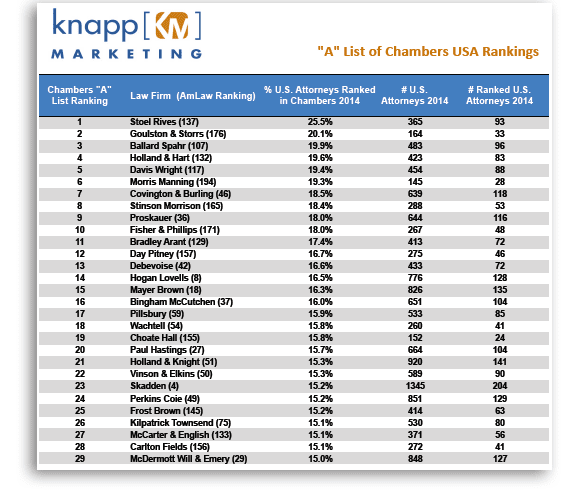This article was previously published in Strategies, May/June 2015.
Want to instantly strike up a rapport with another legal marketer whom you don’t know yet? Share how you feel about Chambers submissions and you’ll be kvetching like old friends in no time! As Chambers season cranks into high gear for another year, we bring you an inside look at firms who have demonstrated excellent results.
In recent years, Knapp Marketing has twice published surveys of Am Law 200 firms’ representation in Chambers. A quick look over those survey results indicates that a small number of firms have a disproportionate percentage of their lawyers listed. In 2014, 29 firms had more than 15% of their USA-based lawyers listed in Chambers. In this article we spoke to six highly successful firms and Laura Mills, Chambers USA editor, to get their inside tips for creating submissions.
Process
The firms we interviewed agree that having a process is a critical component of not ending up with a monthly fire drill from June to December. However, the exact process varies firm to firm, and often from practice group to practice group, based on how the attorneys prefer to work.
Helena Lawrence, a business development manager at Proskauer, discussed the firm’s ongoing efforts. “We have been creating a streamlined process for the last few years to ensure that it’s managed efficiently.”
Tim Delaney, CMO of Ballard Spahr, recommends you stop thinking of Chambers as a seasonal process. “The key to doing this well is to NOT treat it as a Chambers submission, treat it as an on-going process,” he said. “We collect matters from our attorneys in real time when the matter closes and is still fresh in everyone’s mind. Chambers is a fairly heavy lift, but if it is a living, year-round process, that lift is a lot less.”
Success doesn’t seem to be a function of insider knowledge or having your hand held by Chambers.
“Without naming names, I note that the majority of the firms on this list aren’t large consumers of my time (approaching Chambers with many questions or for guidance). They seem to do a good job internally without needing a lot of advice from us,” said Chambers USA Editor Laura Mills. “Overall, the firms who do a great job submitting are the ones who just do exactly what we ask. The firms that stick out to us are the ones who leave out things that we obviously need.” Laura noted that while these particular firms do not ask her a lot of questions, she encourages firms to reach out to her with whatever questions they have, as she’d rather have a firm “ask me a million questions and get it right, than ask none and get it wrong.”
Gathering Matters
Developing a submission strategy, determining matters and identifying references is highly dependent on getting attorney input.
Tim Delaney suggests, “To do this, you need a good communication with your attorneys – including a dialogue about what’s happening in their practice and the matters they are working on. If you’ve got that dialogue, then you can use Chambers as just one of many opportunities to promote their successes.”
One CMO recommended approaching each individual attorney according to how they prefer to interact, such as email, over lunch or in a scheduled 15-minute meeting. Another firm finds that creating a first draft and giving the attorneys something to react to has greatly increased their attorney cooperation.
What about Referees?
Over the years, firms have become aware of the importance of references to Chambers’ process. Some have questioned how this works.
Laura Mills notes, “Firms are worried that we don’t vigorously pursue their referees, but we find the research process works the way it is supposed to. As an example, one New York firm that submits basically nothing to Chambers has more client feedback than any other firm in their practice area. They are hugely represented in band one for that practice solely based on our interviews.”
Peter Columbus, Chief Business Development and Marketing Officer at Mayer Brown, places a strong emphasis on references. “The most important thing we strive for is to make sure we have client and referral sources who will return Chambers’ call or email and participate in Chambers’ process.”
Helena Lawrence notes that, “It’s important to remind lawyers to connect with their references early in the process and make them aware they’ll be contacted for an interview. Client feedback plays a key role in practice rankings and can help to distinguish your firm and its lawyers from peers. Otherwise, to client references, the email from Chambers could be considered spam.”
How do you use Chambers?
Everyone we spoke with seemed to agree that the most valuable result from Chambers is the editorial comments from clients. Like an excellent quote in the media and a client interview result, it’s a reference and a third-party validation in one.
Beth Cuzzone, Director of Business Development at Goulston & Storrs, views the value of the editorial from two angles – one for the time investment to get them and the other from a validation perspective, “We’re taking the time to do it, so we take the time to use it. Chambers quotes are the voice of the client and that voice is prevalent in all we do. We use the rankings in our presentation material, marketing material, and we use some of the quotes and feedback on attorney bios and in RFPs.”
Everyone has asked or heard the question, “Is Chambers important?” We received some insightful responses.
Tim Delaney admits that he has never had a client ask about a ranking, and his attorneys’ attitudes are varied, “Runs the spectrum from no interest to necessary evil to ‘I wouldn’t be a valid practitioner without it.’”
Peter Columbus provided a thoughtful response to this often-asked question. “Does Chambers matter? Some clients like to see that their firms are ranked – it reaffirms that they are working with the best of the best and for the law firms, it reinforces brand credibility. For companies who do not shake up their roster of firms on a regular basis, Chambers provides less value. But for companies that regularly review their panel of law firms, it can help, especially if we don’t have a pre-existing relationship with the company. A Chambers ranking may provide an invitation to participate in an RFP process that you may not have been considered for without it.”
Preparing for this Year’s Submissions
Most Chambers rankings are the result of countless hours of attorney and marketing staff time in pulling together work samples and client references. And even more hours of Chambers’ diligent research are logged to determine which firms’ attorneys are tops in their field. So, as you approach your rankings’ process for Chambers 2016, consider some of the advice given by these top-ranked firms and Chambers’ editor. Make a plan to work smarter, not harder, and to maximize the results your firm receives.


